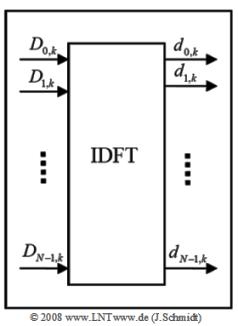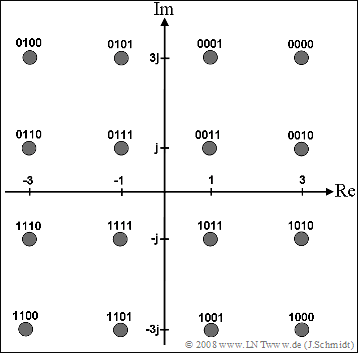Difference between revisions of "Aufgaben:Exercise 5.7: OFDM Transmitter using IDFT"
From LNTwww
| Line 1: | Line 1: | ||
| − | {{quiz-Header|Buchseite= | + | {{quiz-Header|Buchseite=Modulation_Methods/Implementation_of_OFDM_Systems |
}} | }} | ||
| − | [[File:P_ID1662__A_5_7.png|right|frame| | + | [[File:P_ID1662__A_5_7.png|right|frame|Block diagram of the IDFT ]] |
| − | In | + | In this exercise, we take a closer look at an OFDM transmitter implemented using the ''Inverse Discrete Fourier Transform'' $\rm (IDFT)$. Thereby it is valid: |
| − | * | + | * The system has $N = 4$ carriers. |
| − | * | + | * The frame duration is $T_{\ \rm R} = 0.25 \ \rm ms$. |
| − | * | + | * A guard interval is not used. |
| − | * In | + | * In each frame $16$ bits are transmitted. |
| − | * | + | *The upper right diagram shows the block "IDFT" of the OFDM transmitter structure. |
| − | * | + | *Here, four bits each result in a complex symbol according to the $\rm16–QAM$ signal space allocation sketched below left. |
| − | [[File:P_ID1666__A_5_7_Signalraum.png|links|frame| | + | [[File:P_ID1666__A_5_7_Signalraum.png|links|frame|Suggested 16–QAM signal space allocation]] |
| Line 27: | Line 27: | ||
| − | '' | + | ''Notes:'' |
| − | * | + | *The task belongs to the chapter [[Modulation_Methods/Realisierung_von_OFDM-Systemen|Implementation of OFDM Systems]]. |
| − | * | + | *Reference is also made to the chapter [[Signal_Representation/Discrete_Fourier_Transform_(DFT)|Diskrete Fouriertransformation]]. |
| − | * | + | *The equation of the IDFT is with $ν = 0$, ... , $N–1$: |
::$$\quad d_{\nu ,k} = \sum\limits_{\mu = 0}^{N - 1} {D_{\mu ,k} \cdot w^{ - \nu \cdot \mu } } \quad {\rm{mit}} \quad w = {\rm{e}}^{ - {\rm{j}} {\rm{2\pi}}/N}.$$ | ::$$\quad d_{\nu ,k} = \sum\limits_{\mu = 0}^{N - 1} {D_{\mu ,k} \cdot w^{ - \nu \cdot \mu } } \quad {\rm{mit}} \quad w = {\rm{e}}^{ - {\rm{j}} {\rm{2\pi}}/N}.$$ | ||
<br clear=all> | <br clear=all> | ||
| − | === | + | ===Questions=== |
<quiz display=simple> | <quiz display=simple> | ||
Revision as of 16:00, 20 December 2021
In this exercise, we take a closer look at an OFDM transmitter implemented using the Inverse Discrete Fourier Transform $\rm (IDFT)$. Thereby it is valid:
- The system has $N = 4$ carriers.
- The frame duration is $T_{\ \rm R} = 0.25 \ \rm ms$.
- A guard interval is not used.
- In each frame $16$ bits are transmitted.
- The upper right diagram shows the block "IDFT" of the OFDM transmitter structure.
- Here, four bits each result in a complex symbol according to the $\rm16–QAM$ signal space allocation sketched below left.
Notes:
- The task belongs to the chapter Implementation of OFDM Systems.
- Reference is also made to the chapter Diskrete Fouriertransformation.
- The equation of the IDFT is with $ν = 0$, ... , $N–1$:
- $$\quad d_{\nu ,k} = \sum\limits_{\mu = 0}^{N - 1} {D_{\mu ,k} \cdot w^{ - \nu \cdot \mu } } \quad {\rm{mit}} \quad w = {\rm{e}}^{ - {\rm{j}} {\rm{2\pi}}/N}.$$
Questions
Musterlösung
(1) Da hier kein Guard–Intervall berücksichtigt wird, ist die Symboldauer $T$ gleich der Rahmendauer $T_{\rm{R}} = 0.25 \ \rm ms$.
- Bei $N = 4$ Trägern und $\rm 16–QAM$ gilt für die Bitrate am Eingang:
- $$R_{\rm{B}} = \frac{1}{T_{\rm{B}}} = \frac{4 \cdot {\rm{log}_2}\hspace{0.08cm}(16)}{T} = \frac{4 \cdot 4}{0.25\,\,{\rm ms}}\hspace{0.15cm}\underline {= 64\,\,{\rm kbit/s}}.$$
(2) Aus der Signalraumzuordnung folgt für die Trägerkoeffizienten $($auf den Index $k$ wird verzichtet$)$:
- $${\rm{Bitfolge}}\hspace{0.2cm}1111:\hspace{0.5cm} D_0 = -1 - {\rm{j}}\hspace{0.4cm}\Rightarrow\hspace{0.3cm}{\rm Re}[D_0]\hspace{0.15cm}\underline{=-1},\hspace{0.2cm}{\rm Im}[D_0]\hspace{0.15cm}\underline{=-1},$$
- $${\rm{Bitfolge}}\hspace{0.2cm}0111:\hspace{0.5cm} D_1 = -1 + {\rm{j}}\hspace{0.4cm}\Rightarrow\hspace{0.3cm}{\rm Re}[D_1]\hspace{0.15cm}\underline{=-1},\hspace{0.2cm}{\rm Im}[D_1]\hspace{0.15cm}\underline{=+1},$$
- $${\rm{Bitfolge}}\hspace{0.2cm}1000:\hspace{0.5cm} D_2 = +3 - 3{\rm{j}},\hspace{0.15cm}\Rightarrow\hspace{0.3cm}{\rm Re}[D_2]\hspace{0.15cm}\underline{=+3},\hspace{0.2cm}{\rm Im}[D_2]\hspace{0.15cm}\underline{=-3},$$
- $${\rm{Bitfolge}}\hspace{0.2cm}0000:\hspace{0.5cm} D_3 = +3 + 3{\rm{j}}\hspace{0.2cm}\Rightarrow\hspace{0.3cm}{\rm Re}[D_3]\hspace{0.15cm}\underline{=+3},\hspace{0.2cm}{\rm Im}[D_3]\hspace{0.15cm}\underline{=+3}.$$
(3) Die angegebene IDFT–Gleichung lautet mit $N = 4$:
- $$d_{\nu } = \sum\limits_{\mu = 0}^{N - 1} {D_{\mu } \cdot {\rm{e}}^{ \hspace{0.04cm} {\rm{j}}\hspace{0.04cm}\cdot \hspace{0.04cm} \pi/2 \hspace{0.04cm}\cdot \hspace{0.04cm}\nu \hspace{0.04cm}\cdot \hspace{0.04cm} \mu } } .$$
- Daraus erhält man für $ν = 0$, ... , $3$:
- $$d_0 = D_0 + D_1 +D_2 +D_3 = 4 \hspace{2.9cm}\Rightarrow\hspace{0.4cm}{\rm Re}[d_0]\hspace{0.15cm}\underline{=4},\hspace{0.2cm}{\rm Im}[d_0]\hspace{0.15cm}\underline{=0},$$
- $$d_1 = D_0 + {\rm{j}} \cdot D_1 - D_2 -{\rm{j}} \cdot D_3 = -2 + 2 \cdot {\rm{j}}\hspace{0.4cm}\Rightarrow\hspace{0.4cm}{\rm Re}[d_1]\hspace{0.15cm}\underline{=-2},\hspace{0.2cm}{\rm Im}[d_1]\hspace{0.15cm}\underline{=+2},$$
- $$d_2 = D_0 - D_1 + D_2 - D_3 = -8 \cdot {\rm{j}}\hspace{2.1cm}\Rightarrow\hspace{0.4cm}{\rm Re}[d_2]\hspace{0.15cm}\underline{=0},\hspace{0.2cm}{\rm Im}[d_2]\hspace{0.15cm}\underline{=-8},$$
- $$d_3 = D_0 - {\rm{j}} \cdot D_1 - D_2 +{\rm{j}} \cdot D_3 = -6 + 6 \cdot {\rm{j}}\hspace{0.4cm}\Rightarrow\hspace{0.4cm}{\rm Re}[d_3]\hspace{0.15cm}\underline{=-6},\hspace{0.2cm}{\rm Im}[d_3]\hspace{0.15cm}\underline{=+6}.$$
(4) Richtig sind die beiden letzten Lösungsvorschläge:
- Bei OFDM ist der Crest–Faktor eher groß.
- Dies kann bei den verwendeten Verstärkerschaltungen zu Problemen in Bezug auf Linearitätsanforderungen und Energieeffizienz führen.

